Kinetics of Zinc Evaporation from Aluminium Alloys Melted Using VIM and ISM Technologies
Abstract
1. Introduction
- Induction furnace with a non-conductive crucible, e.g., ceramic crucible;
- Induction furnace with a conductive crucible, e.g., graphite crucible or copper crucible in case of the cold crucible furnace.
- Approximating the surface of liquid Al-Zn alloy melted using VIM and ISM technologies;
- Laboratory smelting of these alloys in variable pressure and temperature;
- Estimation of the overall mass transfer coefficient of zinc on the basis of experimental data;
- Determination of the stages in finding the velocity of the analysed evaporation process.
2. Materials and Methods
2.1. A Thermodynamic Condition of Zinc Evaporation from Liquid Aluminium
2.2. Experimental Procedures
3. Results
4. Discussion
- Acquisition of images of the molten metal with the use of a high-speed camera;
- Determination of the resulting meniscus geometry on the basis of the obtained photos;
- Determination of the functions of the curves describing the meniscus for various process parameters;
- Estimation of the surface area using the programs Wolfram Mathematica (F1).
4.1. Mass Transfer in the Liquid Phase
4.2. Evaporation from the Surface
4.3. Mass Transfer in the Gaseous Phase
5. Conclusions
- Determination of the values of the overall mass transfer coefficient kZn regarding the evaporating component;
- Estimation of the values of mass transfer coefficients in the liquid phase βl and the evaporation rate constant ke;
- Determination of the stages defining the investigated process.
- For the experiments carried out in the crucible induction furnace, reduction in the operating pressure in the furnace from 1000 Pa to 10 Pa, together with the increase in temperature from 953 K to 1103 K, is accompanied by a decrease in zinc content in the alloy from 6 to 96%, compared with the initial value. Simultaneously, the overall mass transfer coefficient kZn increases from 5.15 × 10−6 to 1.49 × 10−4 ms−1.
- For the experiments carried out in the furnace with a cold crucible (T = 953 K), a reduction in the operating pressure in the furnace from 1000 Pa to 10 Pa resulted in a decrease in zinc content in the alloy from 18 to 80%, compared with the initial value. Simultaneously, the overall mass transfer coefficient kZn increases from 5.17 × 10−6 to 3.34 × 10−5 ms−1.
- For comparison, the experiments carried out in the crucible induction furnace at 953 K showed a reduction in zinc content in the alloy from 6 to 50%, which means that more intense zinc evaporation is seen in the furnace with a cold crucible. This effect is caused by a far larger evaporation surface (liquid metal surface) for this device (Table 4).
- The rate of analysed zinc evaporation within 100 Pa to1000 Pa is controlled by the mass transfer rate in the gaseous phase. The overall resistance associated with mass transfer in the liquid phase (Rβl) and with the reaction on the liquid metal surface (Re) was up to 22% of the overall process resistance for this pressure range.
- For 10 Pa, the overall resistance associated with mass transfer in the liquid phase (Rβl) and with the reaction on the liquid metal surface (Re) constitutes nearly 70% of the overall process resistance.
Author Contributions
Funding
Institutional Review Board Statement
Informed Consent Statement
Data Availability Statement
Conflicts of Interest
References
- Wecki, B. Analysis of the Influence of the Contact Area Size between the Liquid Metal Phase and the Gas Phase on the Efficiency of the Metal Refining Process in Induction Crucible Furnaces. Ph.D. Dissertation, Silesian University of Technology, Gliwice, Poland, 2018. [Google Scholar]
- Deng, H.; Dong, J.; Boi, F.; Saunders, T.; Hu, C.; Grasso, S. Magnetic Field Generated during Electric Current—Assisted Sintering: From Health and Safety Issues to Lorentz Force Effects. Metals 2020, 10, 1653. [Google Scholar] [CrossRef]
- Smalcerz, A.; Przylucki, R. Electromagnetic Field Analysis of Inductor—Robot-Workpiece System. Metalurgija 2013, 52, 223–226. [Google Scholar]
- Niklewicz, M.; Smalcerz, A. Application of three-coil cylindrical inductor in induction heating of gears. Electr. Rev. 2010, 86, 333–335. [Google Scholar]
- Niklewicz, M.; Smalcerz, A. Estimation of system geometry and inductor frequency importance in induction hardening process of gears. Electr. Rev. 2008, 84, 219–224. [Google Scholar]
- Biesuz, M.; Saunders, T.; Ke, D.; Reece, J.M.; Hu, C.; Grasso, S. A review of electromagnetic processing of materials (EPM): Heating, sintering, joining and forming. J. Mater. Sci. Technol. 2021, 69, 239–272. [Google Scholar] [CrossRef]
- Gombert, D.; Richardson, J.; Aloy, A.; Delbert, D. Cold-Crucible design parameters for next generation HLW melters. Waste Manag. 2002, 2, 24–28. [Google Scholar]
- Vogt, M.; Bernier, F.; Mühlbauer, A.; Blum, M.; Jarczyk, G. Experimental investigation of temperature field and energy flows in induction furnace with cold crucible and a practical application of the results. In Proceedings of the International Conference Electromagnetic Processing of Materials EPM 2000, Nagoya, Japan, 3–6 April 2000. [Google Scholar]
- Baake, E.; Nacke, B.; Bernier, F.; Vogt, M.; Mühlbauer, A.; Blum, M. Experimental and numerical investigations of the temperature field and melt flow in the induction furnace with cold crucible. In Proceedings of the International Symposium on Heating by Internal Sources HIS 2001, Padua, Italy, 12–14 September 2001. [Google Scholar]
- Lavers, J.D.; Biringer, P.P.; Segsworth, R.S. Current distribution, forces and circulation in the coreless furnace. IEEE Trans. Ind. Appl. 1973, 4, 395–399. [Google Scholar] [CrossRef]
- Bojarevics, V.; Djambazov, G.; Harding, R.; Pericleous, K.; Wickins, M. Investigation of the cold crucible melting, Process: Experimental and Numerical Study. Proc. Fifth Int. Pamir Conf. Fundam. Appl. MHD 2002, 2, II.77–II.82. [Google Scholar]
- Delage, D.; Ernst, R.; Driole, J. Induction melting in a cold crucible. In Proceedings of the Symposium IUTAM, Cambridge, UK, 7–11 June 1982; p. 108. [Google Scholar]
- Gagnoud, A.; Etay, J.; Garnier, M. The levitation melting process using cold crucible technique. ISIJ Int. 1988, 28, 38. [Google Scholar] [CrossRef]
- Guo, J.; Liu, Y.; Su, Y. Evaporation of multi-components in Ti-25Al-25Nb melt during induction skull melting process. Trans. Nonferrous Met. Soc. China 2002, 12, 587–591. [Google Scholar]
- Olette, M. Physical Chemistry of Process Metallurgy; Part 2; St-Pierre, G.R., Ed.; Interscience: New York, NY, USA, 1961; pp. 1065–1087. [Google Scholar]
- Plewa, J. Przykłady Obliczeń z Teorii Procesów Metalurgicznych; Wydawnictwo Politechniki Śląskiej: Gliwice, Poland, 1987. [Google Scholar]
- Roine, A. HSC Chemistry ver. 6.1 Thermo-Chemical Database; Outotec Research Oy: Pori, Finland, 2007. [Google Scholar]
- Ward, R.G. Evaporative losses during vacuum induction melting of steel. J. Iron Steel Inst. 1963, 1, 11–15. [Google Scholar]
- Nash, P.M.; Steinemann, S.G. Density and Thermal Expansion of Molten Manganese. Iron. Nickel. Copper. Aluminium and Tin by Means of the Gamma-Ray Attenuation Technique. Phys. Chem. Liq. Int. J. 1995, 29, 43–58. [Google Scholar] [CrossRef]
- Assael, M.; Kakosimos, K.; Banish, R. Reference Data for the Density and Viscosity of Liquid Aluminum and Liquid Iron. J. Phys. Chem. Ref. Data 2006, 35, 285–300. [Google Scholar] [CrossRef]
- Yoshida, T.; Nagasaka, T.; Hino, M. Evaporation Rates of Zinc and Lead in Copper Melt under Reduce Pressure. J. Jpn. Inst. Met. 1999, 63, 167–173. [Google Scholar] [CrossRef][Green Version]
- Ma, Y.; Qui, K. Separation and recovery of zinc from copper-based alloy scraps under vacuum conditions. Vacuum 2014, 106, 5–10. [Google Scholar] [CrossRef]
- Hino, M.; Wang, S.; Nagasaka, T.; Ban-Ya, S. Evaporation Rate of Zinc in Liquid lron. ISIJ Int. 1994, 34, 491–497. [Google Scholar] [CrossRef]
- Wei, Q.; Yang, B.; Li, Y.; Dai, Y. Zinc Removing from Aluminum alloy by Vacuum Distillation. Adv. Mater. Res. 2012, 402, 303–306. [Google Scholar] [CrossRef]
- Machlin, E.S. Kinetics of Vacuum Induction Refining—Theory. Trans. Am. Inst. Min. Metall. Eng. 1960, 218, 314–326. [Google Scholar]
- Przyłucki, R.; Golak, S.; Oleksiak, B.; Blacha, L. Influence of an induction furnace’s electric parameters on mass transfer velocity in the liquid phase. Metalurgija 2012, 1, 67–70. [Google Scholar]
- Blacha, L.; Przyłucki, R.; Golak, S.; Oleksiak, B. Influence of the geometry of the arrangement inductor—Crucible to the velocity of the transport of mass in the liquid metallic phase mixed inductive. Arch. Civ. Mech. Eng. 2011, 11, 171–179. [Google Scholar]
- Blacha, L.; Golak, S.; Jakovics, S.; Tucs, A. Kinetic Analysis of Aluminum Evaporation from Ti-6Al-7Nb. Arch. Metall. Mater. 2014, 59, 275–279. [Google Scholar] [CrossRef]
- Blacha, L.; Fornalczyk, A.; Przyłucki, R.; Golak, S. Kinetics of the evaporation process of the volatile component in induction stirred melts. In Proceedings of the 2nd International Conference of Simulation and Modelling of Metallurgical Processes in Steelmaking, Steelsim 2007, Graz, Austria, 12–14 September 2007; Ludwig, A., Ed.; ASMET: Leoben, Austria, 2007; pp. 389–395. [Google Scholar]
- Aldalur, E.; Suárez, A.; Veiga, F. Metal transfer modes for Wire Arc Additive Manufacturing Al-Mg alloys: Influence of heat input in microstructure and porosity. J. Mater. Process. Technol. 2021, 297, 117271. [Google Scholar] [CrossRef]
- Du, Y.; Chang, Y.; Huang, B.; Gong, W.; Jin, Z. Diffusion coefficients of some solutes in fcc and liquid Al: Critical evaluation and correlation. Mater. Sci. Eng. A 2003, 363, 140–151. [Google Scholar] [CrossRef]
- Harris, R.; Davenport, W.G. Vacuum distillation of liquid metals. Metall. Trans. B 1982, 13, 581–588. [Google Scholar] [CrossRef]
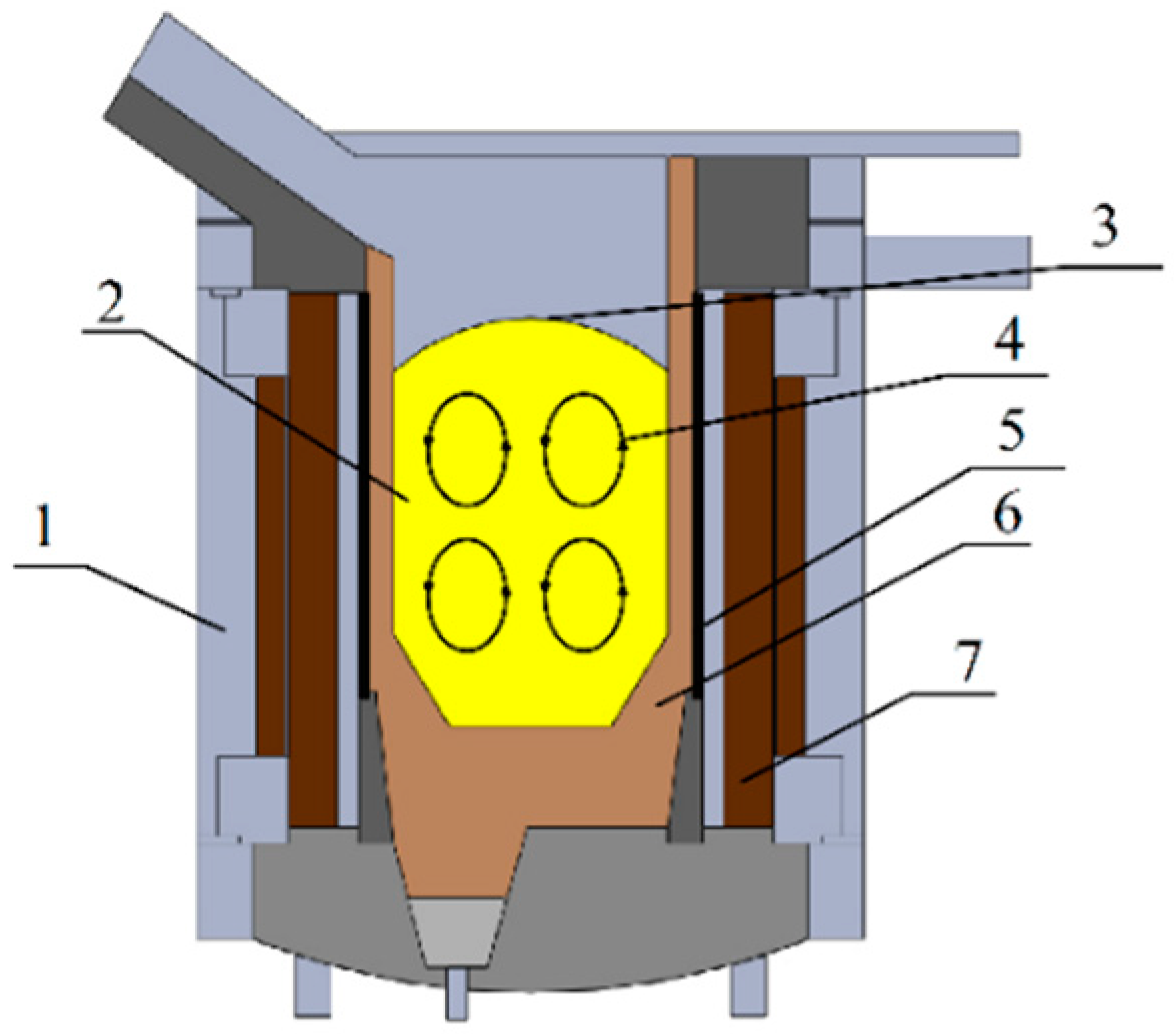
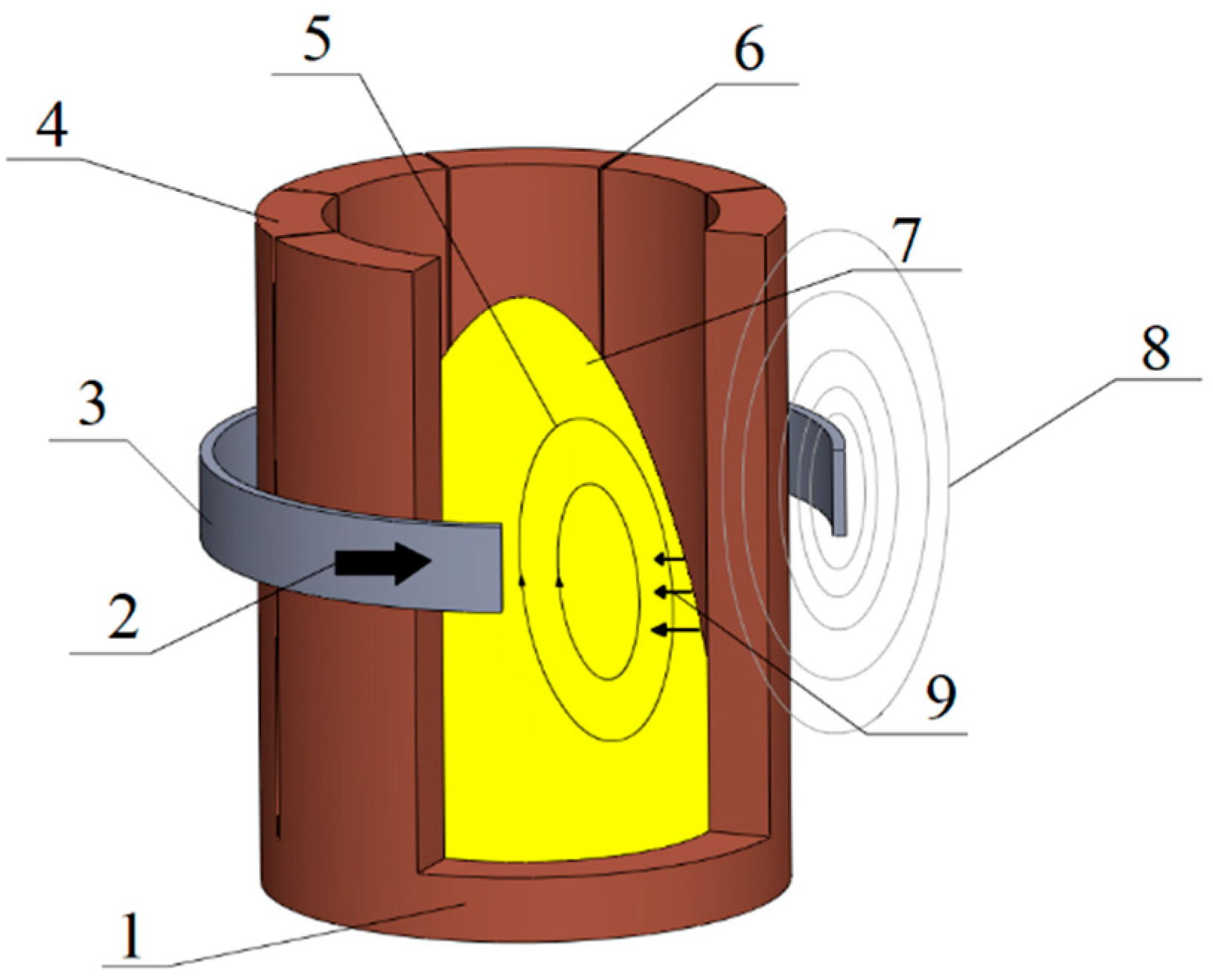
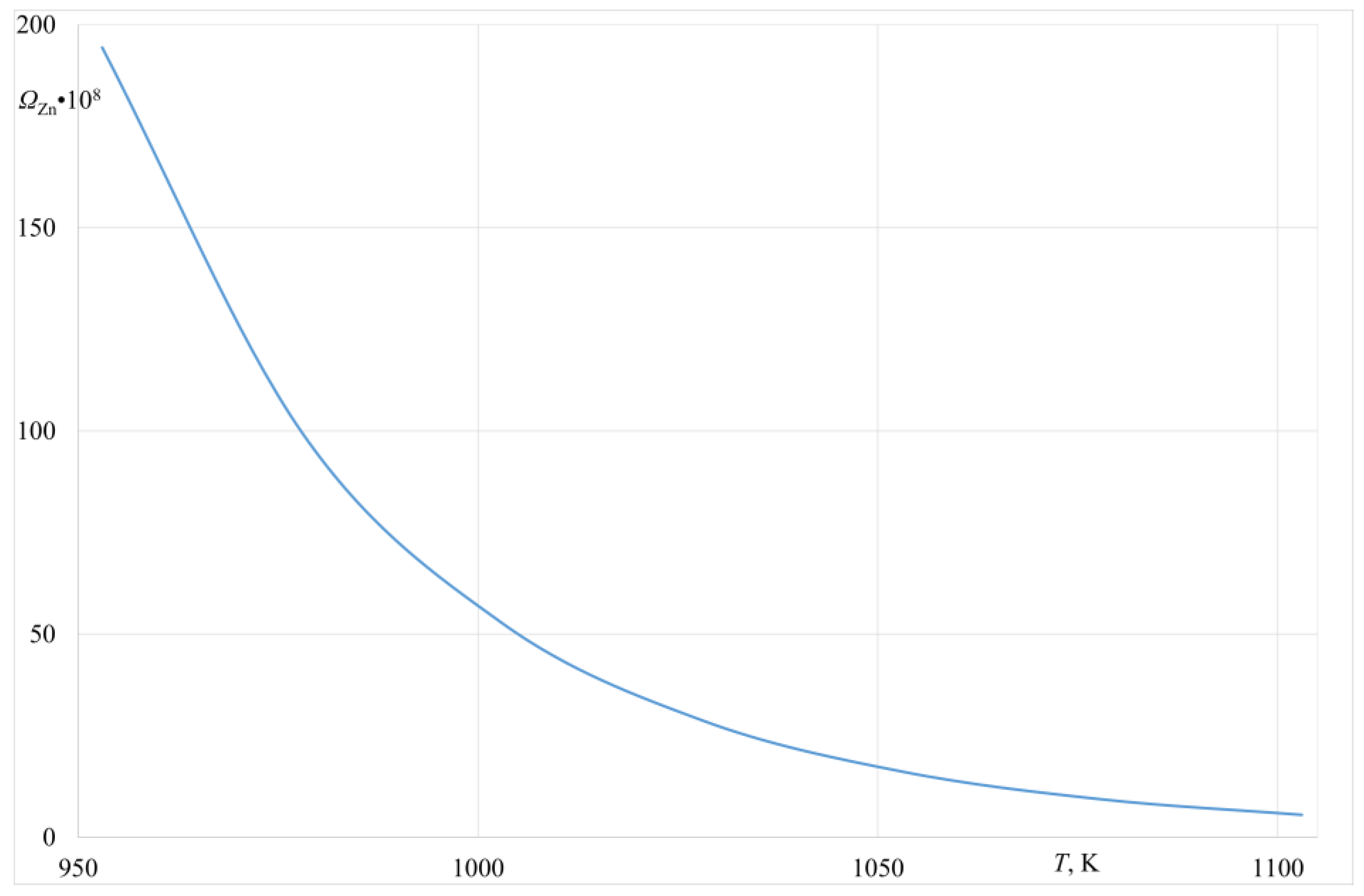

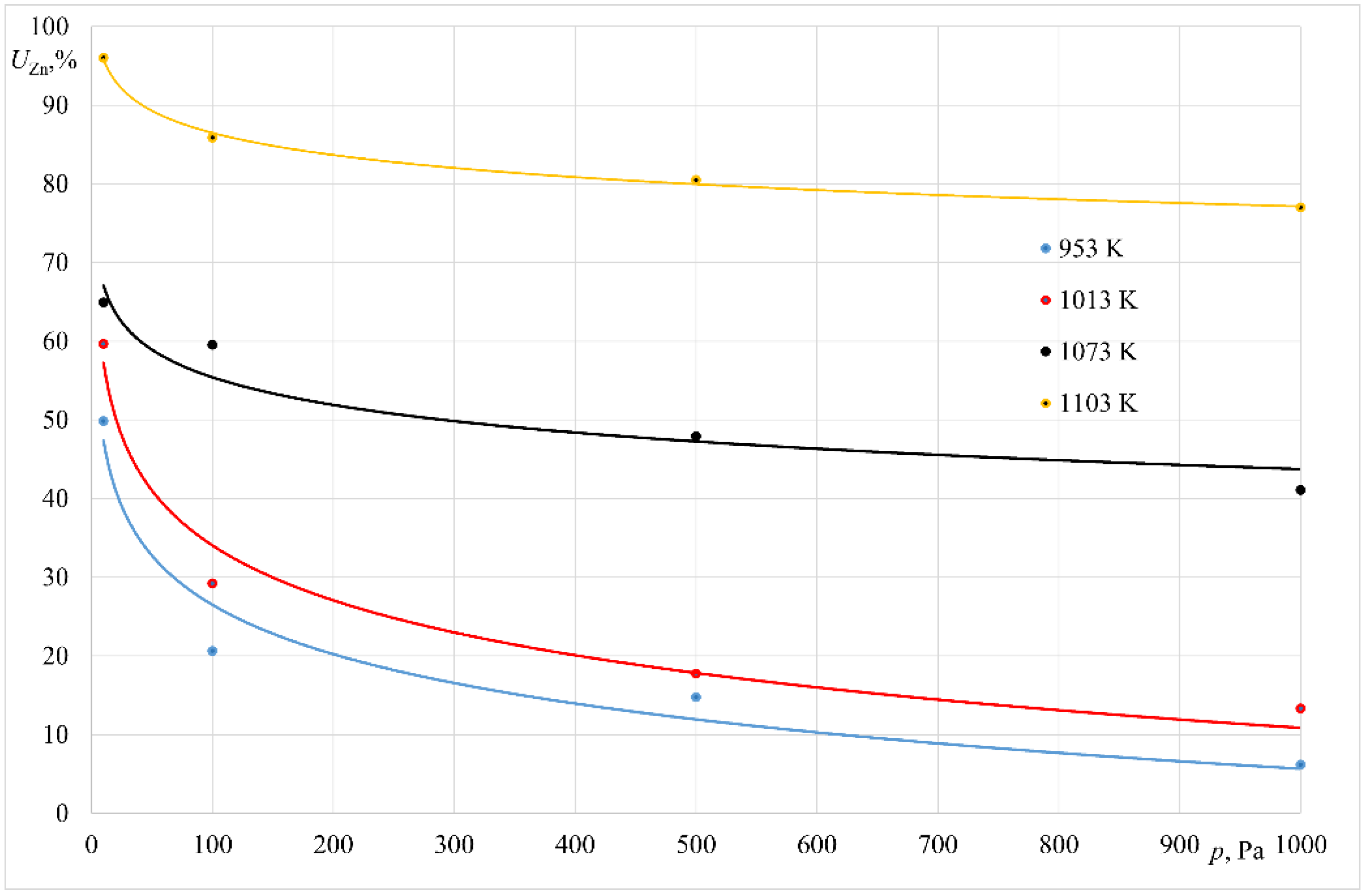
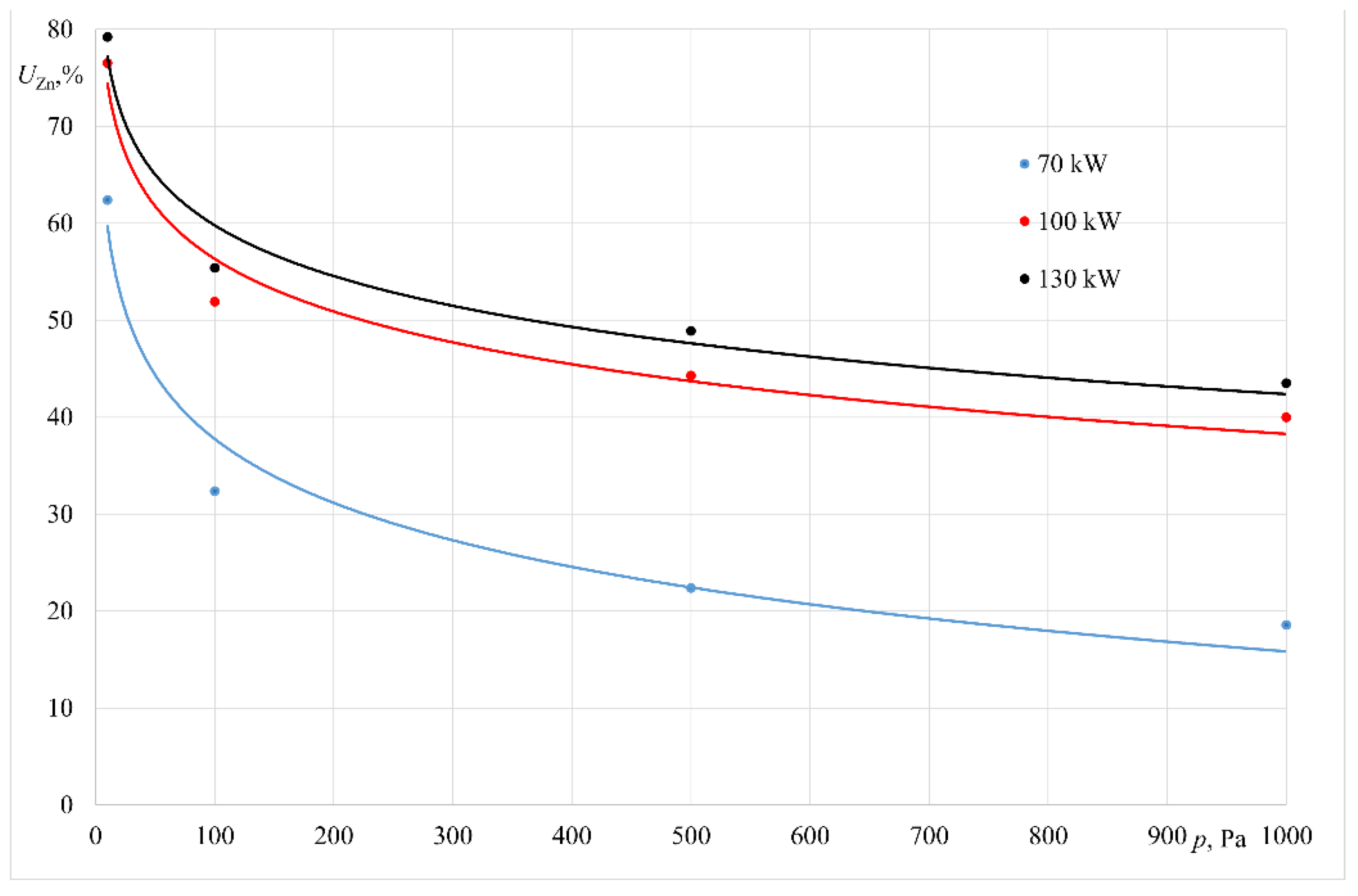
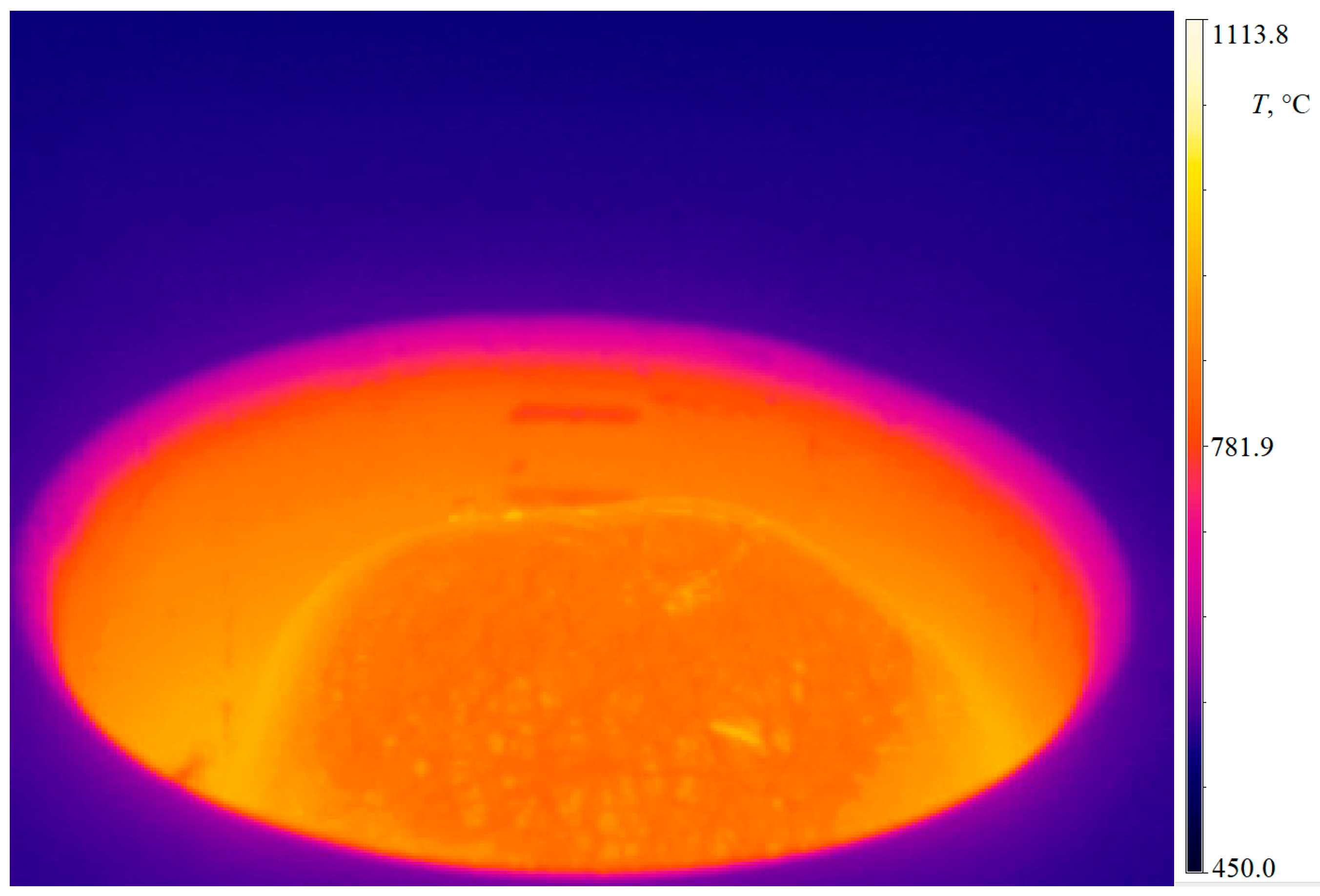
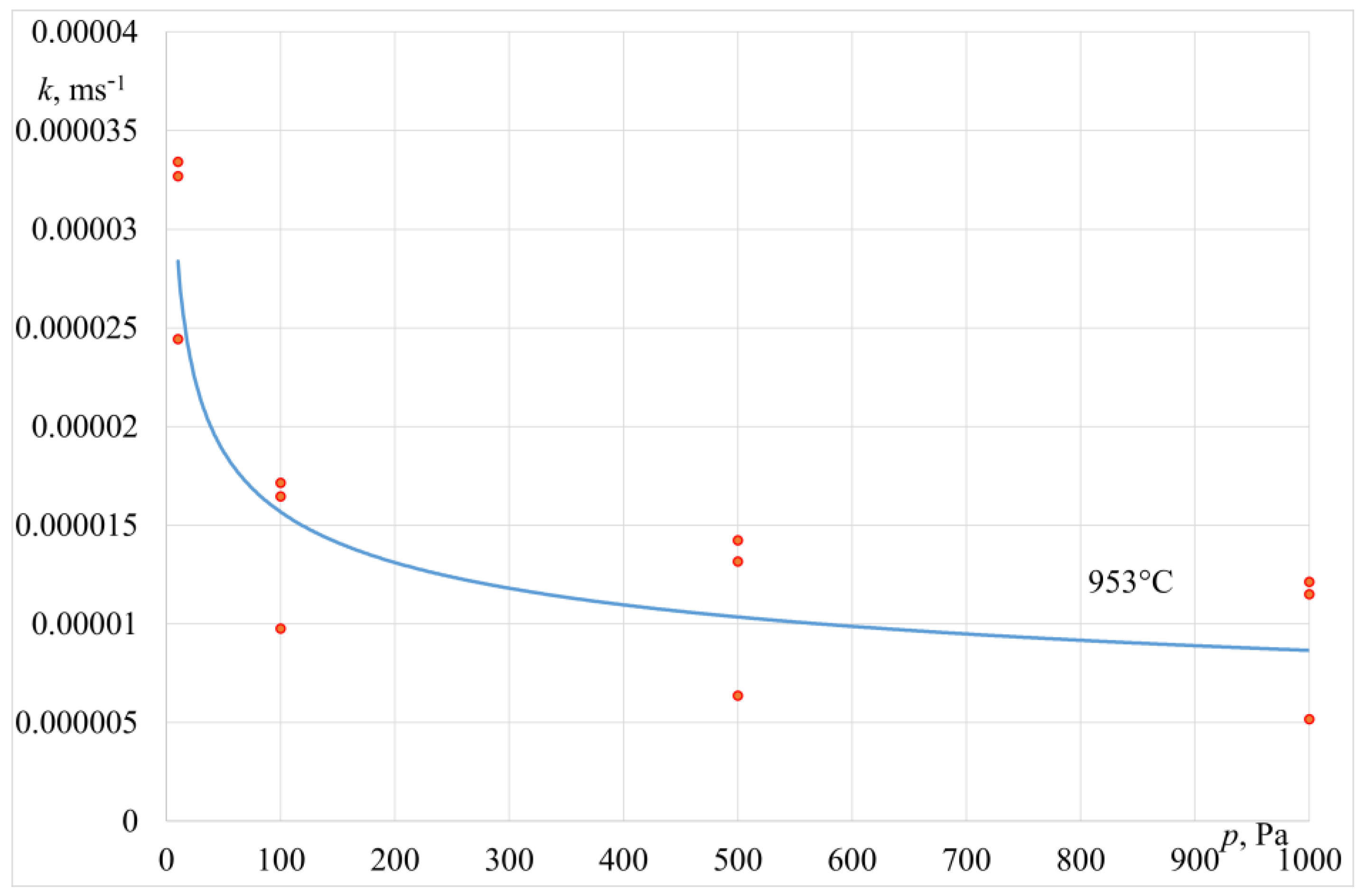
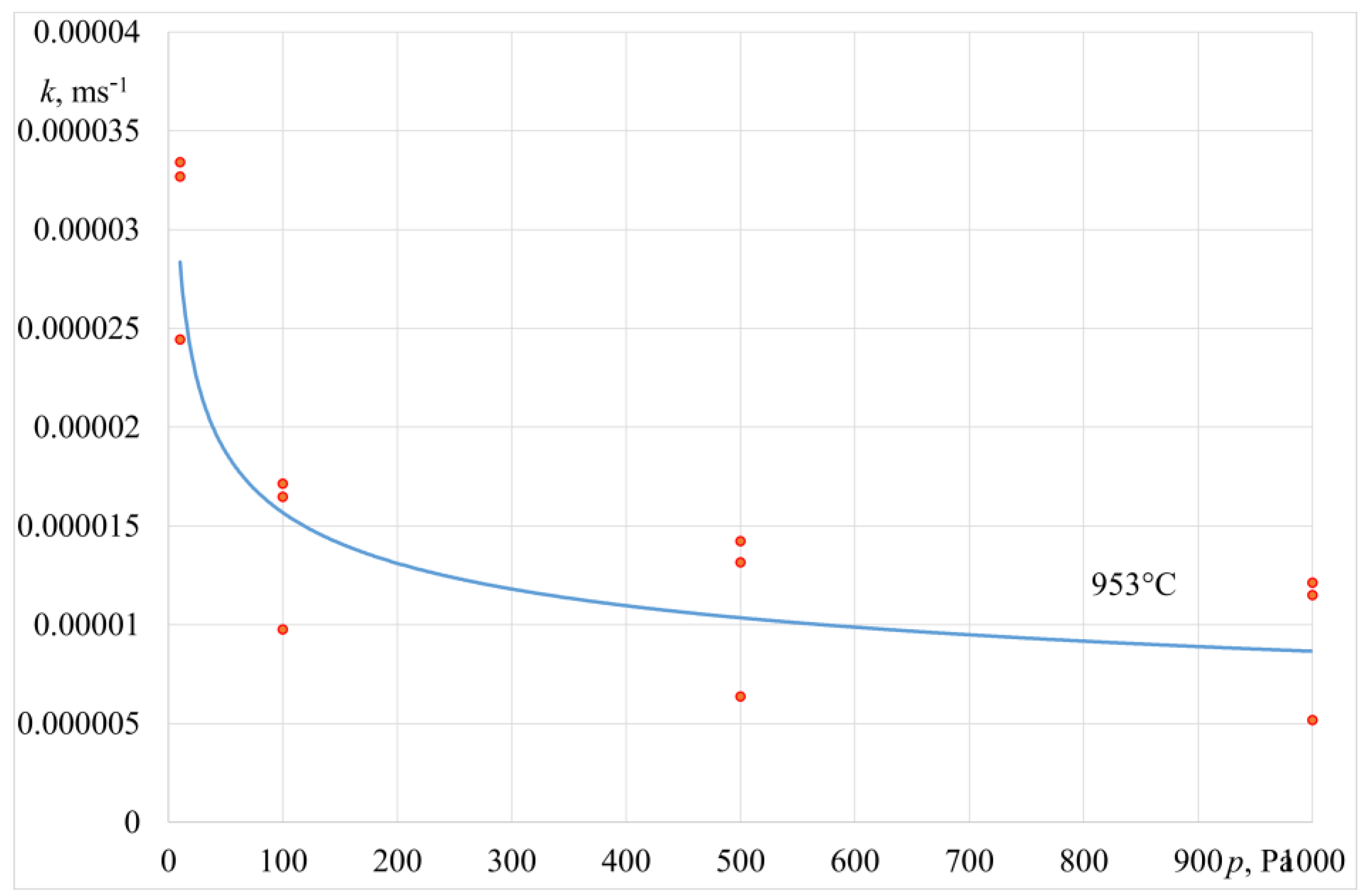
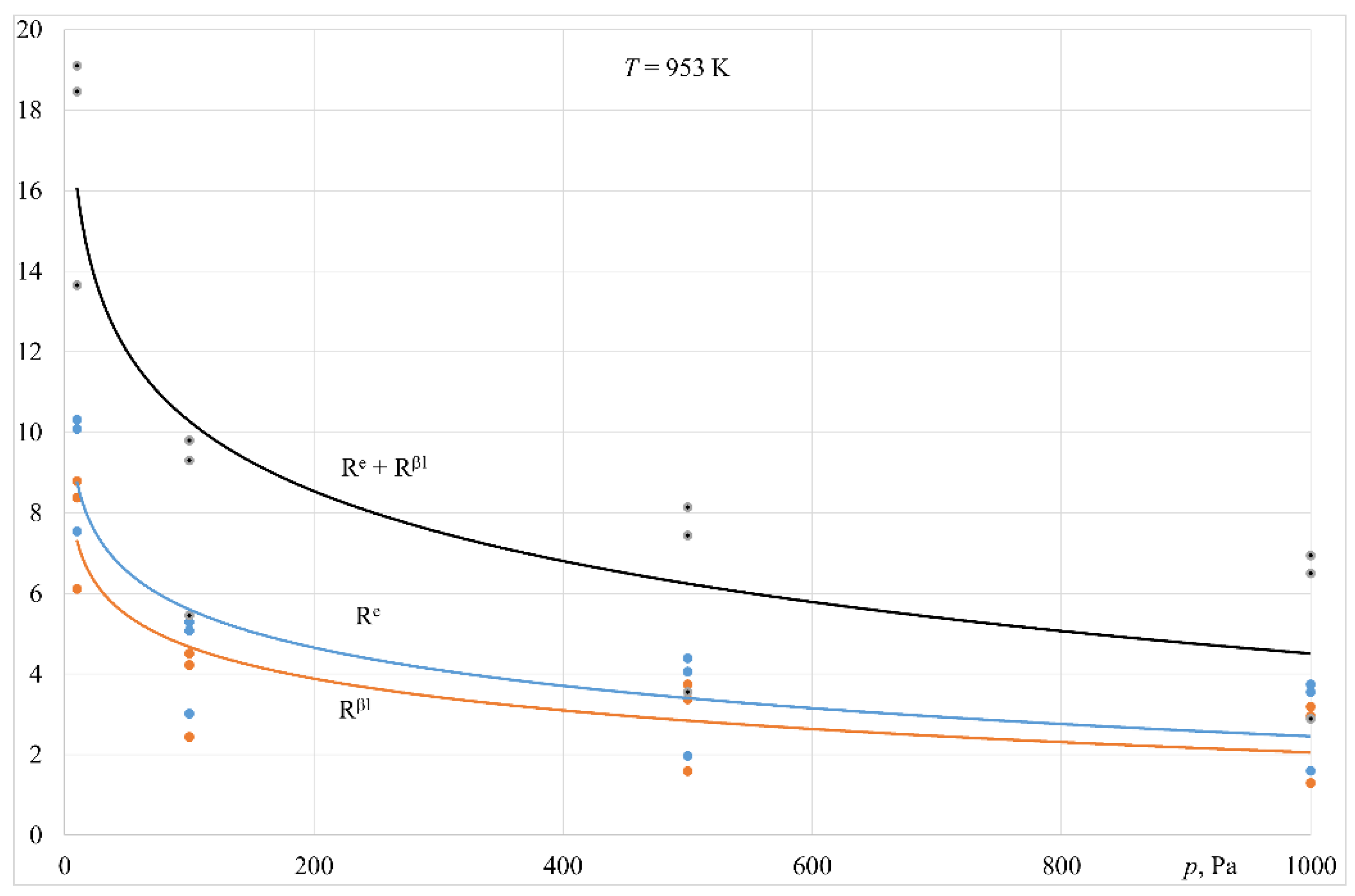
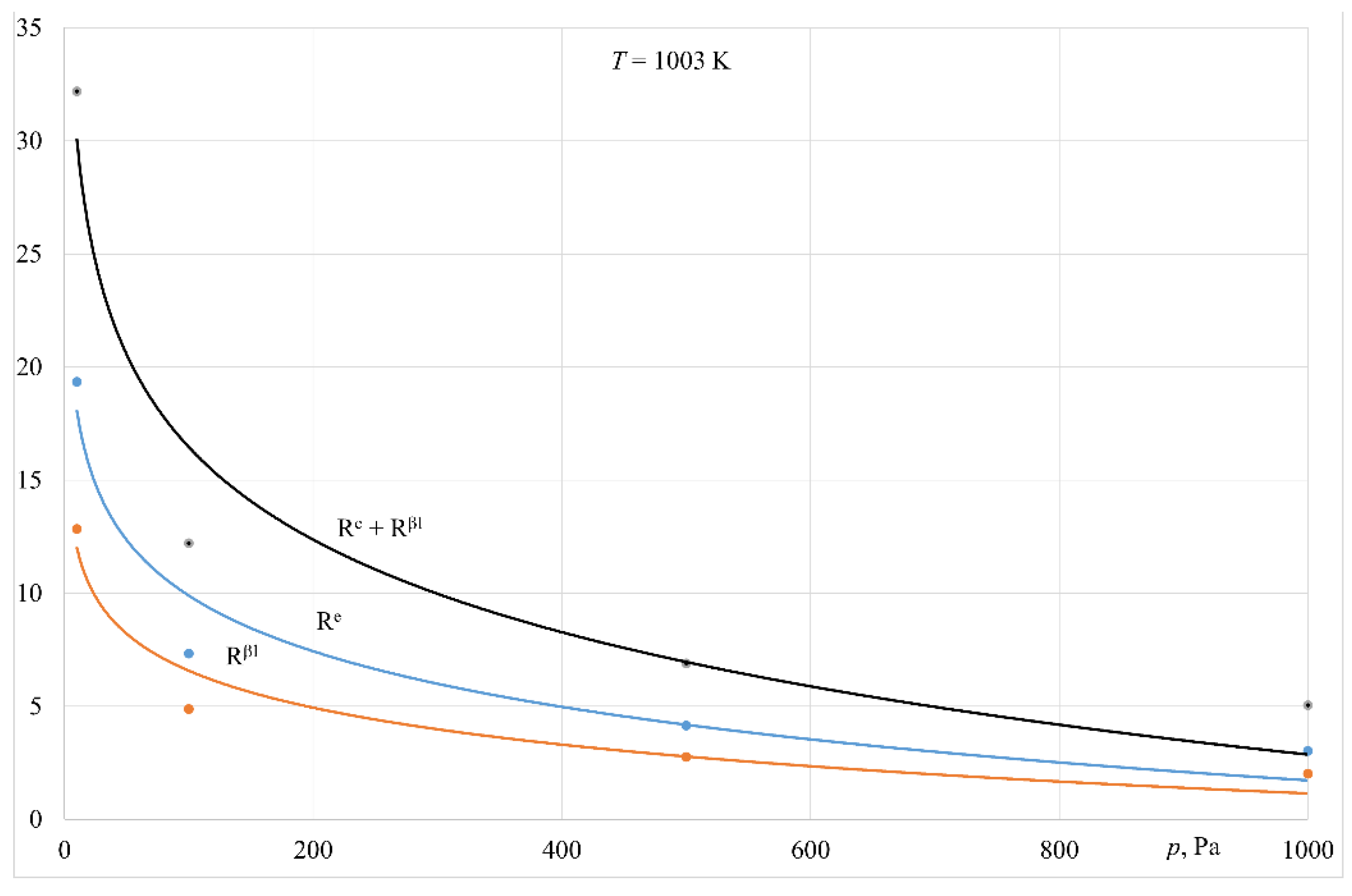
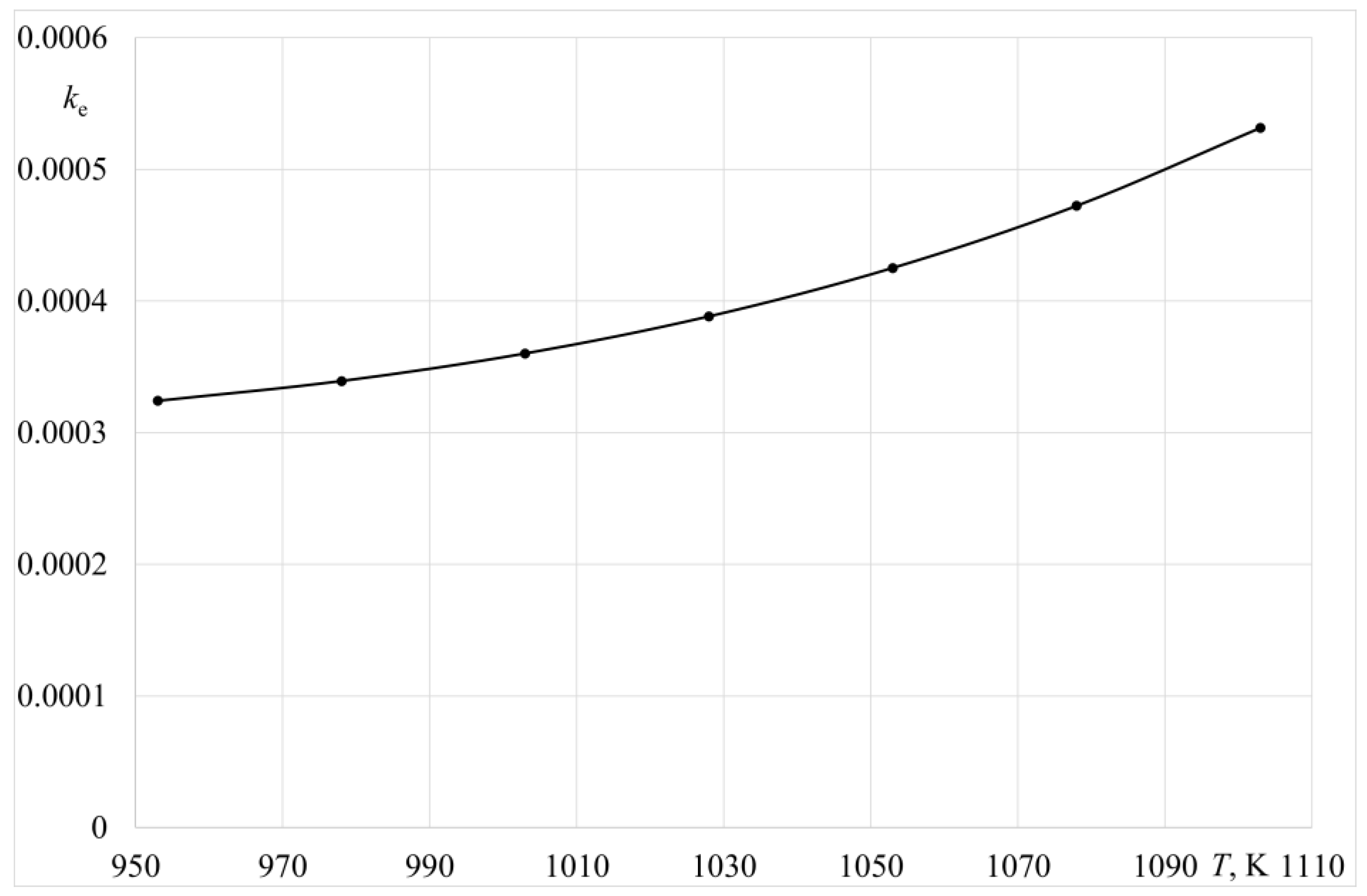
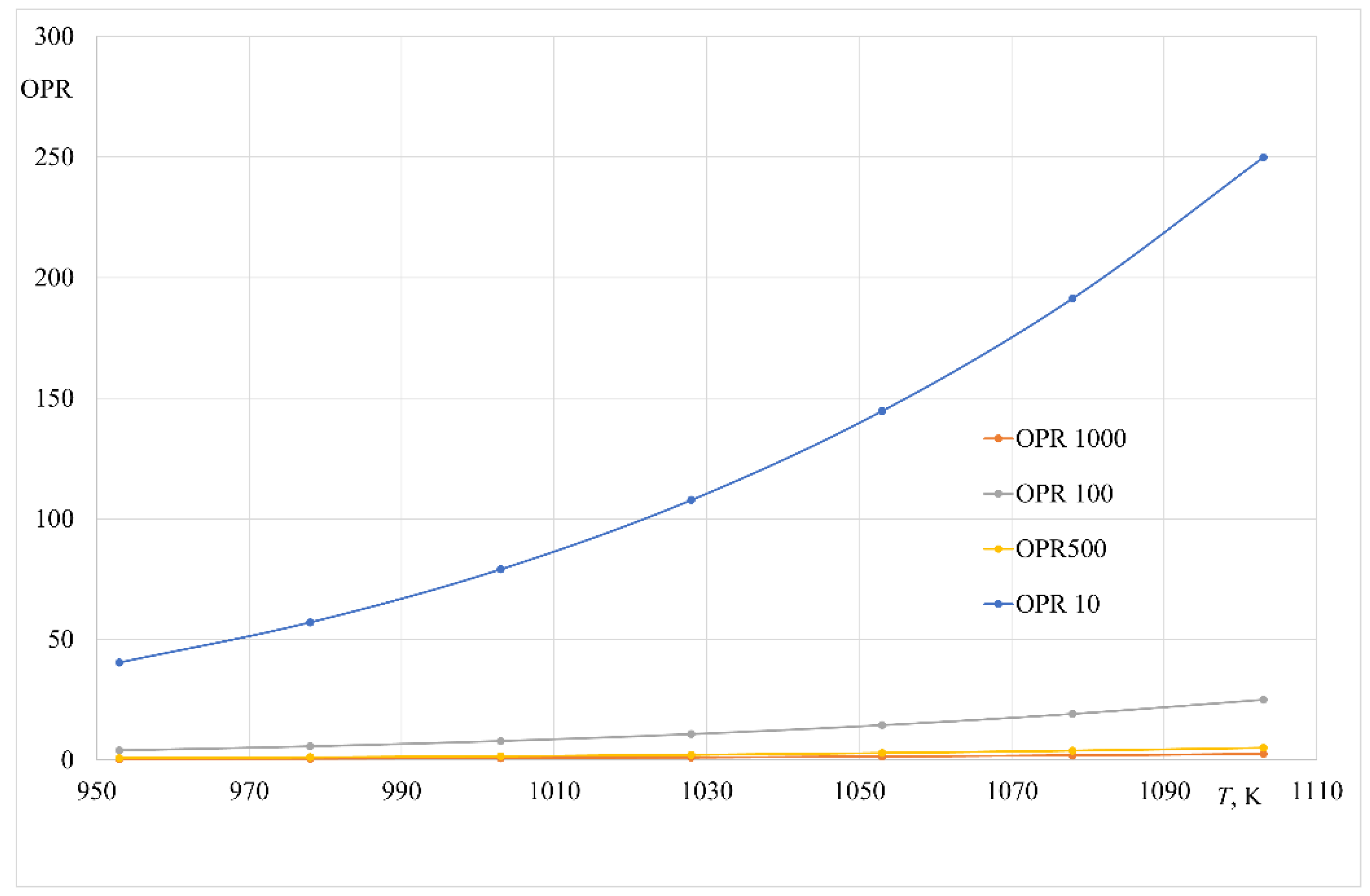
| Content of Basic Alloy Components. wt.% | |||||||||
|---|---|---|---|---|---|---|---|---|---|
| Zn | Mg | Cu | Mn | Fe | Si | Cr | Ti | Zr | Al |
| 6.3 | 2.5 | 1.6 | 0.3 | <0.5 | <0.4 | 0.23 | <0.05 | 0.01 | residue |
| No. | T, K | p, Pa | Final Zinc Concentration, wt.% | UZn, % |
|---|---|---|---|---|
| 1 | 953 | 1000 | 5.91 | 6.19 |
| 2 | 953 | 500 | 5.37 | 14.76 |
| 3 | 953 | 100 | 5.00 | 20.63 |
| 4 | 953 | 10 | 3.16 | 49.84 |
| 5 | 1013 | 1000 | 5.46 | 13.33 |
| 6 | 1013 | 500 | 5.18 | 17.77 |
| 7 | 1013 | 100 | 4.46 | 29.20 |
| 8 | 1013 | 10 | 2.54 | 59.68 |
| 9 | 1073 | 1000 | 3.71 | 41.11 |
| 10 | 1073 | 500 | 3.28 | 47.93 |
| 11 | 1073 | 100 | 2.55 | 59.52 |
| 12 | 1073 | 10 | 2.21 | 64.92 |
| 13 | 1103 | 1000 | 1.45 | 76.98 |
| 14 | 1103 | 500 | 1.23 | 80.47 |
| 15 | 1103 | 100 | 0.89 | 85.87 |
| 16 | 1103 | 10 | 0.25 | 96.03 |
| No. | T, K | p, Pa | Operating Power, kW | Final Zinc Concentration, wt.% | UZn, % |
|---|---|---|---|---|---|
| 1 | 953 | 1000 | 70 | 5.13 | 18.57 |
| 2 | 953 | 500 | 70 | 4.89 | 22.38 |
| 3 | 953 | 100 | 70 | 4.26 | 32.38 |
| 4 | 953 | 10 | 70 | 2.37 | 62.38 |
| 5 | 953 | 1000 | 100 | 3.78 | 40.01 |
| 6 | 953 | 500 | 100 | 3.51 | 44.28 |
| 7 | 953 | 100 | 100 | 3.03 | 51.90 |
| 8 | 953 | 10 | 100 | 1.48 | 76.50 |
| 9 | 953 | 1000 | 130 | 3.56 | 43.49 |
| 10 | 953 | 500 | 130 | 3.22 | 48.88 |
| 11 | 953 | 100 | 130 | 2.81 | 55.39 |
| 12 | 953 | 10 | 130 | 1.31 | 79.20 |
| No. | p, kW | Furnace | F, cm2 |
|---|---|---|---|
| 1 | 8 | VIM | 88.1 |
| 2 | 12 | VIM | 92.4 |
| 3 | 17 | VIM | 108.7 |
| 4 | 22 | VIM | 155.0 |
| 5 | 70 | ISM | 280.0 |
| 6 | 100 | ISM | 311.8 |
| 7 | 130 | ISM | 330.3 |
| 8 | 8 | VIM | 88.1 |
| 12 | 12 | VIM | 92.4 |
| T, K | p, Pa | kZn, m s−1 | βlZn, m s−1 | keZn, m s−1 |
|---|---|---|---|---|
| 5953 | 1000 | 0.00000515 | 0.000549 | 0.000324 |
| 953 | 500 | 0.0000129 | 0.000549 | 0.000324 |
| 953 | 100 | 0.0000185 | 0.000549 | 0.000324 |
| 953 | 10 | 0.0000556 | 0.000549 | 0.000324 |
| 1013 | 1000 | 0.0000109 | 0.000542 | 0.00036 |
| 1013 | 500 | 0.0000149 | 0.000542 | 0.00036 |
| 1013 | 100 | 0.0000264 | 0.000542 | 0.00036 |
| 1013 | 10 | 0.0000696 | 0.000542 | 0.00036 |
| 1073 | 1000 | 0.0000351 | 0.00052 | 0.000425 |
| 1073 | 500 | 0.0000426 | 0.00052 | 0.000425 |
| 1073 | 100 | 0.0000592 | 0.00052 | 0.000425 |
| 1073 | 10 | 0.0000685 | 0.00052 | 0.000425 |
| 1103 | 1000 | 0.0000673 | 0.000478 | 0.000531 |
| 1103 | 500 | 0.0000748 | 0.000478 | 0.000531 |
| 1103 | 100 | 0.0000896 | 0.000478 | 0.000531 |
| 1103 | 10 | 0.000149 | 0.000478 | 0.000531 |
| T, K | p, Pa | p, kW | kZn, m s−1 | βlZn, m s−1 | keZn, m s−1 |
|---|---|---|---|---|---|
| 953 | 1000 | 70 | 0.00000517 | 0.0004 | 0.000324 |
| 953 | 500 | 70 | 0.00000636 | 0.0004 | 0.000324 |
| 953 | 100 | 70 | 0.000009768 | 0.0004 | 0.000324 |
| 953 | 10 | 70 | 0.00002444 | 0.0004 | 0.000324 |
| 953 | 1000 | 100 | 0.00001151 | 0.00039 | 0.000324 |
| 953 | 500 | 100 | 0.00001316 | 0.00039 | 0.000324 |
| 953 | 100 | 100 | 0.00001646 | 0.00039 | 0.000324 |
| 953 | 10 | 100 | 0.00003268 | 0.00039 | 0.000324 |
| 953 | 1000 | 130 | 0.00001213 | 0.00038 | 0.000324 |
| 953 | 500 | 130 | 0.00001423 | 0.00038 | 0.000324 |
| 953 | 100 | 130 | 0.00001714 | 0.00038 | 0.000324 |
| 953 | 10 | 130 | 0.0000334 | 0.00038 | 0.000324 |
Publisher’s Note: MDPI stays neutral with regard to jurisdictional claims in published maps and institutional affiliations. |
© 2021 by the authors. Licensee MDPI, Basel, Switzerland. This article is an open access article distributed under the terms and conditions of the Creative Commons Attribution (CC BY) license (https://creativecommons.org/licenses/by/4.0/).
Share and Cite
Smalcerz, A.; Wecki, B.; Blacha, L.; Labaj, J.; Jodkowski, M.; Smagor, A. Kinetics of Zinc Evaporation from Aluminium Alloys Melted Using VIM and ISM Technologies. Materials 2021, 14, 6641. https://doi.org/10.3390/ma14216641
Smalcerz A, Wecki B, Blacha L, Labaj J, Jodkowski M, Smagor A. Kinetics of Zinc Evaporation from Aluminium Alloys Melted Using VIM and ISM Technologies. Materials. 2021; 14(21):6641. https://doi.org/10.3390/ma14216641
Chicago/Turabian StyleSmalcerz, Albert, Bartosz Wecki, Leszek Blacha, Jerzy Labaj, Maciej Jodkowski, and Adrian Smagor. 2021. "Kinetics of Zinc Evaporation from Aluminium Alloys Melted Using VIM and ISM Technologies" Materials 14, no. 21: 6641. https://doi.org/10.3390/ma14216641
APA StyleSmalcerz, A., Wecki, B., Blacha, L., Labaj, J., Jodkowski, M., & Smagor, A. (2021). Kinetics of Zinc Evaporation from Aluminium Alloys Melted Using VIM and ISM Technologies. Materials, 14(21), 6641. https://doi.org/10.3390/ma14216641









